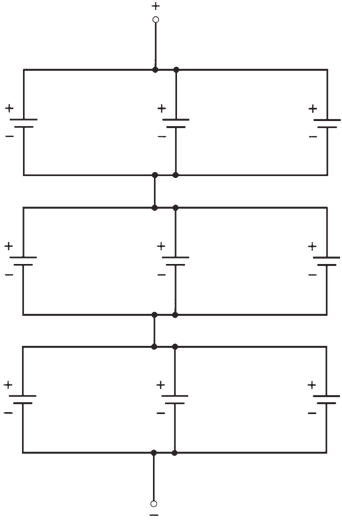Photovoltaic cells and batteries:
The photovoltaic cell is totally different from any electrochemical cells, it is known as a solar cell. This device converts visible light, infrared, and ultraviolet directly into the electric current.
Solar panels
Several, photovoltaic cells can be combined in series parallel to create a solar panel. An example is shown in the Figure given below. Although this shows a 3 × 3 series parallel array, the matrix is not required to be doe symmetrical. It might comprise of, say, 50 parallel sets of 20 series connected cells. The series scheme boosts voltage to the desired level, and parallel scheme increases current-delivering ability of the panel. It is not unusual to see hundreds of solar cells combined togather in this manner to obtain a large panel.
Construction and performance
The construction of a photovoltaic cell is shown in Figure given below. The device is a flat semi conductor P-N junction, and the assembly is made transparent so that light can directly fall on P-type silicon. The metal ribbing, forming positive electrode and is interconnected by means of tiny wires. The negative electrode is the metal backing, placed in contact with N-type silicon. Most of the solar cells provide about 0.5 V. If there is low current demand, dim light will result in full output voltage from a solar cell. As the current demand increases, brighter light is required to produce the full output voltage. There is a maximum limit to current which can be provided from the solar cell, no matter how bright the light. This limit can be increased by connecting solar cells in the parallel.
Practical applications
Solar cells have become more efficient in the recent years, as researchers have looked to them as a long term alternative energy source. Solar panels are used in the satellites. They can be used in conjunction with the rechargeable batteries, like the lead-acid or nickel-cadmium types, to give power independent of the commercial utilities.
A completely independent solar power system is called as stand-alone system. It uses large solar panels generally, large capacity lead acid or NICAD batteries, power converters to convert direct current into alternating current, and a sophisticated charging circuit. These systems are best appropriate to environments where there is sunshine a high percent of the time.
Solar cells, alone or supplemented with rechargeable batteries, can be connected into home electric system in an interactive arrangement with electric utilities. When the solar power system cannot provide for the requirement of the household all by itself, the utility company can take up the slack. On the other hand, when the solar power system supplies more than enough for the requirement of the home, the utility company can buy excess.

Figure: Connection of cells in series-parallel.